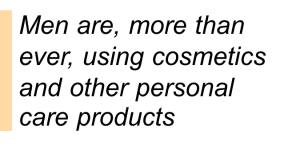Anti-Aging? It’s More and More a Man’s World
Has is really been over two decades since the portmanteau “metrosexual” was coined? Just how did its originator, British writer Mark Simpson, describe this archtype when he launched it upon an unsuspecting world?
Metrosexual man, the single young man with a high disposable income, living or working in the city (because that’s where all the best shops are), is perhaps the most promising consumer market of the decade. In the Eighties he was only to be found inside fashion magazines such as GQ. In the Nineties, he’s everywhere and he’s going shopping.
Today, the term seems somehow out of date, because we know that male urbanite audiences are too complex and fragmented to be summed up in a single term, so applying it – just like using “yuppie” – sounds simplistic and outmoded.

More grooms are using makeup on their wedding days, for example. Not just gay men, but straight ones, too. And why not? As one told the New York Post, “It made me feel like I deserve this day. I deserve to look good and feel really confident going into that ceremony.”
Taking a manly stand against aging
So we shouldn’t be surprised how swiftly men are adding anti-aging products as part of their regular regimen, though that trend has really taken off with millennials, who are proactive and liberated from the norms when it comes to a lot of issues…including personal care. The 2015 Men’s Grooming Consumer Report from NPD made that clear, even as it also reminded us that it’s a growth market, as only 22% of men regularly use facial skin care.
Traditionally, men weren’t taught to look for problems with their skin, just to cleanse it. Now there are products ranging from cleansers to densifying shampoos and hand cream age spot correctors.
There are life stage factors at work, of course. Older men are increasingly aware of ageism in the workplace (no doubt to women’s wry amusement), and are taking increasing advantage of surgical solutions in an effort to appear youthful and competitive.
It’s all contributing to a growing marketplace, as the men’s grooming segment in the U.S. is valued at $5.5 billion, with anti-aging products making up a significant chunk of that total. According to Mintel and other market researchers, some of the factors driving male acceptance of anti-aging products include…
- Increased penetration of crossover products, such as skin care product with anti-aging and sun protection features, or anti-dandruff products that also help prevent hair loss
- Holistic skin care approaches that go beyond combating wrinkles into areas like eye treatments, night creams and serums
- More natural and organic skin care brand options focused on attracting and converting a male audience
- Men’s native interest in multifunctional products at that are “fast and effective problem-solvers”
Overall, the global market was worth nearly $50BN last year, with moisturizers, pomades, body hair removal products and blemish concealers taking over more and more physical and digital shelf space. Retail sales of male grooming products at Procter & Gamble, including its Gillette brand, were more than $11BN, while Unilever, with its Axe and Lynx brands, sold nearly $5BN in 2015, according to Euromonitor.
Look to the East
If you want to see where the U.S. and European men’s facial care and anti-aging markets may be headed, regard Asia, where use of these products among men is far more prevalent and accepted. Asian men have been devoted to skin health for a long time, and use as many as five to seven products as part of their routine. That would be a dream scenario for marketers trying to enlist U.S. audiences.
Yet even in Asia, there’s considerable upside at stake. China, especially, is a market where major brands are trying to drive greater acceptance and adoption, especially when they compare it against a market like South Korea, where widespread use of male skin care products is an accepted fact of life.
However pervasive the use of make skin care products becomes in Western markets, it’s a safe bet to assume we haven’t yet seen the ceiling for those products. Especially as innovations come along that will make anti-aging skin care more palatable for more and more men.
